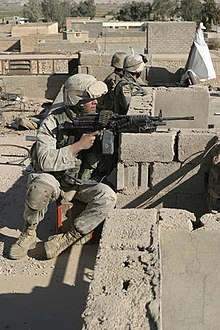Operation Steel Curtain
| Operation Steel Curtain | |||||||
|---|---|---|---|---|---|---|---|
| Part of the Iraq War | |||||||
 A U.S. Marine and Iraqi Army soldiers watch over the surrounding streets from a rooftop in Karabilah, Iraq, during Operation Steel Curtain on 11 November 2005. | |||||||
| |||||||
| Belligerents | |||||||
Other insurgents | |||||||
| Commanders and leaders | |||||||
| Casualties and losses | |||||||
10 killed, 30 wounded[1] | 139 insurgents killed, 256 captured | ||||||
97+ civilians killed[2] | |||||||
Operation Steel Curtain (Arabic: الحجاب الفولاذي Al Hejab Elfulathi) was a military operation executed by coalition forces in early November 2005 to reduce the flow of foreign insurgents crossing the border and joining the Iraqi insurgency. The operation was important in that it was the first large scale deployment of the New Iraqi Army. This offensive was part of the larger Operation Sayeed (Hunter), designed to prevent al Qaeda in Iraq from operating in the Euphrates River Valley and throughout Al Anbar and to establish a permanent Iraqi Army presence in the Al Qa’im region.
Contents
1 Operation
2 Aftermath
3 References
4 External links
Operation
On 5 November, Marines from 3rd Battalion, 6th Marines and 2nd Battalion, 1st Marines began their assault on insurgent-held Karabilah, and had cleared the city four days later. Then on 10 November the coalition forces began to attack the city of Husaybah and pursue any insurgents who fled Karabilah. After four more days of fighting in Husaybah, the coalition troops launched another phase of the operation into the city of Ubaydi, an insurgent haven and site of the earlier Operation Matador. The fortified city fell to coalition forces after seven days of fighting, bringing a conclusion to Operation Steel Curtain. The assault on Sadah and a small portion of Karabilah was known as "Operation: Iron Fist". The assault of Husaybah and Karabilah was "Operation: Steel Curtain". So named because the resident leader of anti-coalition forces, al-Zarqawi, said they would hold on to Husaybah with an "iron fist". Named by Coalition Commanders, "Operation Steel Curtain", was a hardened sweep and clear mission hence "steel curtain" because one of the SNCOs was a Pittsburgh Steelers fan.
Aftermath
U.S. officials reported that the operation killed 139 insurgents and took 256 more prisoners, and considered it successful. Battle positions were constructed, preventing the insurgency from regaining control of the city. At least 10 U.S. Marines and an unknown number of Iraqi soldiers died.[3][4][5]
A local physician from Husaybah, Zahid Mohammed Rawi, said that medical workers had counted 97 civilians killed in the first week of the operation.[2]
References
^ Period Details Archived 17 October 2006 at the Wayback Machine
^ ab Knickmeyer, Ellen (24 December 2005). "U.S. Airstrikes Take Toll on Civilians". The Washington Post. Retrieved 2 November 2016..mw-parser-output cite.citation{font-style:inherit}.mw-parser-output .citation q{quotes:"""""""'""'"}.mw-parser-output .citation .cs1-lock-free a{background:url("//upload.wikimedia.org/wikipedia/commons/thumb/6/65/Lock-green.svg/9px-Lock-green.svg.png")no-repeat;background-position:right .1em center}.mw-parser-output .citation .cs1-lock-limited a,.mw-parser-output .citation .cs1-lock-registration a{background:url("//upload.wikimedia.org/wikipedia/commons/thumb/d/d6/Lock-gray-alt-2.svg/9px-Lock-gray-alt-2.svg.png")no-repeat;background-position:right .1em center}.mw-parser-output .citation .cs1-lock-subscription a{background:url("//upload.wikimedia.org/wikipedia/commons/thumb/a/aa/Lock-red-alt-2.svg/9px-Lock-red-alt-2.svg.png")no-repeat;background-position:right .1em center}.mw-parser-output .cs1-subscription,.mw-parser-output .cs1-registration{color:#555}.mw-parser-output .cs1-subscription span,.mw-parser-output .cs1-registration span{border-bottom:1px dotted;cursor:help}.mw-parser-output .cs1-ws-icon a{background:url("//upload.wikimedia.org/wikipedia/commons/thumb/4/4c/Wikisource-logo.svg/12px-Wikisource-logo.svg.png")no-repeat;background-position:right .1em center}.mw-parser-output code.cs1-code{color:inherit;background:inherit;border:inherit;padding:inherit}.mw-parser-output .cs1-hidden-error{display:none;font-size:100%}.mw-parser-output .cs1-visible-error{font-size:100%}.mw-parser-output .cs1-maint{display:none;color:#33aa33;margin-left:0.3em}.mw-parser-output .cs1-subscription,.mw-parser-output .cs1-registration,.mw-parser-output .cs1-format{font-size:95%}.mw-parser-output .cs1-kern-left,.mw-parser-output .cs1-kern-wl-left{padding-left:0.2em}.mw-parser-output .cs1-kern-right,.mw-parser-output .cs1-kern-wl-right{padding-right:0.2em}
^ "The Geography of War". Newsweek. 11/6, 2006. Archived from the original on 27 November 2006. Retrieved 24 July 2007. Check date values in:|date=(help)
^ Ricks, Thomas E. (9/11, 2006). "Situation Called Dire in West Iraq". Washington Post. Retrieved 24 July 2007. Check date values in:|date=(help)
^ John Pike (2000). "Release A051122d - Operation Steel Curtain concludes". globalsecurity. Retrieved 24 July 2007.
External links
| Wikimedia Commons has media related to Operation Steel Curtain. |
- CNN report on offensive
- Cafe-Syria report
- Marine Corps News
- Battle plan
- Multinatinal force Iraq
- Video of firefight from US position